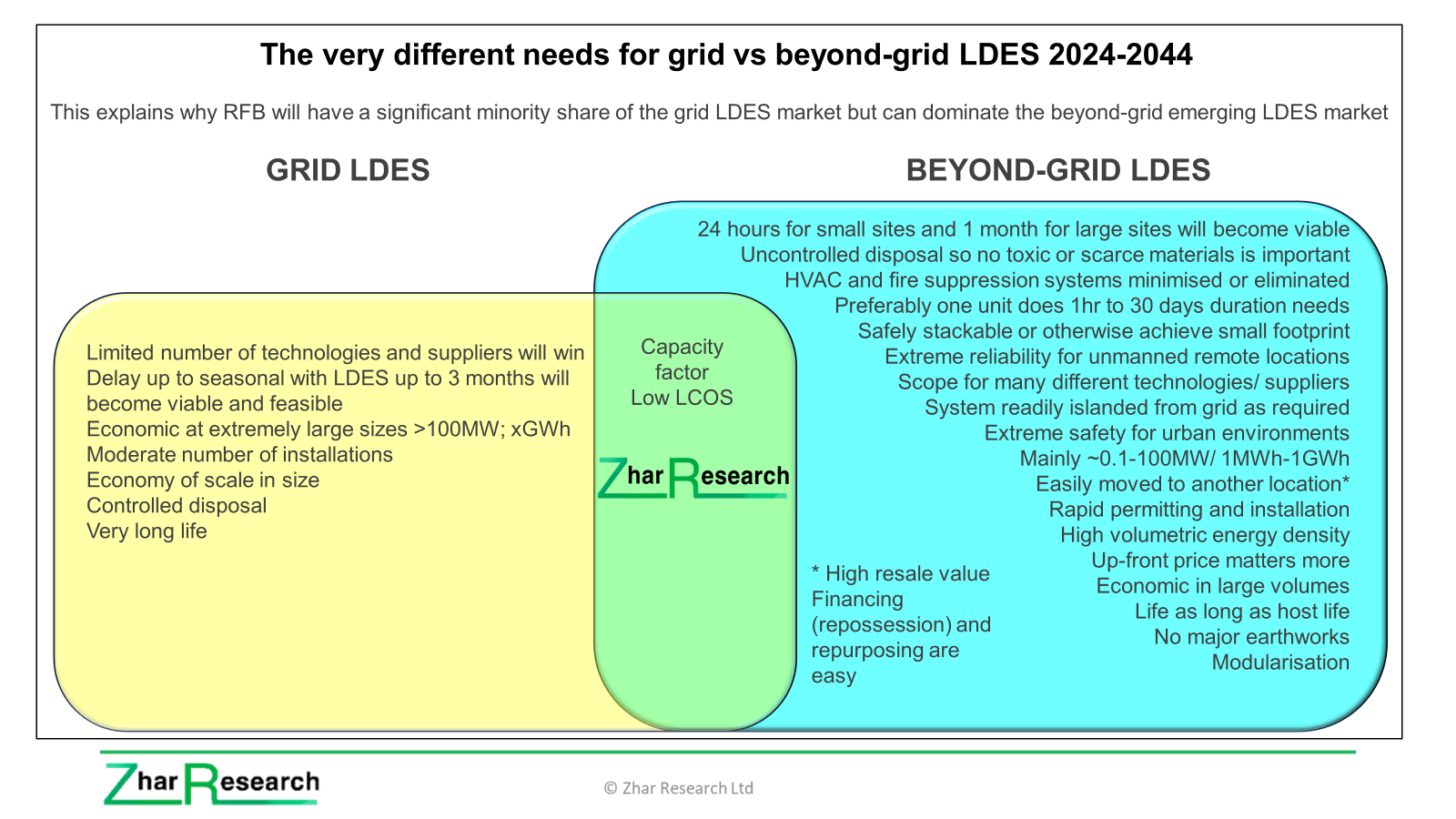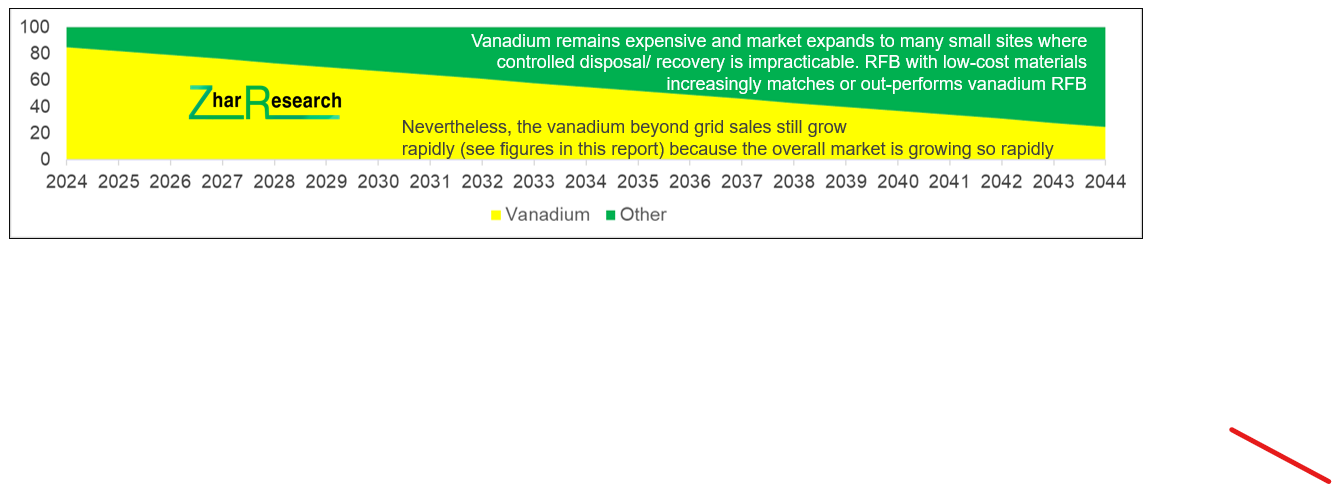Redox Flow Batteries Pivot to a Different Success
It was an active decade. In the 1970s, practicable redox flow batteries RFB, supercapacitors and lithium-ion batteries first appeared. All of these had initial success in one market but their biggest opportunity now comes from arrival of a new, strong, appropriate demand.
Lessons from other energy storage
Lithium-ion batteries started in small things. Then electric vehicles arrived, increasing their sales tenfold. For supercapacitors, it was also in small things, inside electric vehicles being a false dawn for them, but now they may hit the big time with large ones in roadside fast chargers for heavy electric vehicles, in laser and other electromagnetic weapons, rail guns and thermonuclear power, particularly as most suppliers have now redesigned them to eliminate the acetonitrile carcinogen.
Reasons for a slow start
RFB had a tougher time, not least because the others look like a component but an RFB looks more like a chemical factory. Most RFB are non-flammable, lasting at least 30 years and capable of being designed for up to one month duration to balance wind and solar power intermittency. However, that is the norm for much of the other next-generation large energy storage, much of which also looks like a chemical factory, but with fewer toxicity issues than RFB. Think compressed and liquid air and pushing water up mountains. RFB has therefore only had modest sales to utilities and others for grid-connected sites. These sales have not even caught up with supercapacitor sales (which are to different markets) to exceed one billion dollars yearly. There are only around 50 RFB manufacturers and putative manufacturers, around half of the number making supercapacitors. They do not compete.
New report predicts a pivot
The new Zhar Research report, “Redox Flow Batteries: 26 Market Forecasts, Roadmaps, Technologies, 48 Manufacturers, Latest Research Pipeline 2024-2044” spells out how the norm for RFB has been tanks of very corrosive, acid, expensive vanadium salts with toxicity issues. The companies making these nevertheless offer extremely reliable, safe products well proven even in military facilities. These companies are typically partly owned or backed by giants that mine vanadium and/ or believe in a major breakthrough for grid applications. One VRFB manufacturer will build an 800MWh giant soon to prove the point and Zhar Research believes that a $1 billion RFB company will be created in this way as VRFB sales continue to grow for another twenty years. Candidates include Rongke Power in China making the giant and companies that have already sold hundreds of smaller units such as Invinity Energy Systems with more than 275 in operation, around 25MWh total, and CellCube with 140+ installed totalling over 75MWh.
But how about RFB copying lithium-ion batteries and supercapacitors in seeing their biggest opportunity in the arrival of a new and very appropriate market and even new design principles better able to address it? Yes, says Zhar Research. It is “beyond-grid” meaning for systems that are off-grid, only using the grid for back-up or at least capable of being “islanded”. It includes the battery in your solar house but more accessible is a plethora of islands, mines, telecom. towers, military bases, hospitals, schools, farms and so on. The grid opportunity remains but RFB can never dominate it.
The beyond-grid sector is now the largest RFB opportunity because it most needs the RFB uniques and it will become large. VRFB already have success in this sector and will continue to do so. However, pivoting to non-vanadium RFB can create a $5 billion manufacturer in what will become an overall RFB market of over $20 billion in 2044. Ye,s that in merely where lithium-ion batteries are today, but by then lithium-ion will have collapsed in the face of a variety of far lower cost, non-flammable, non-toxic alternatives variously appropriate for electronics to electric vehicles and grids. Nothing is forever.
Evidence of RFB pivoting in design and application
Zhar Research gives the evidence. When you sell millions, the cost is critical and controlled disposal is unlikely so avoiding expensive materials and their reuse and reducing toxigen issues become more important. In these volume markets, small footprint matters and hybrid RFB are sometimes half the size. Indeed all RFB can be safely stacked and they need less or none of the complex firefighting and air conditioning. Redflow (zinc bromine RFB) already claims 285 deployed with 2,959MWh. Iron-based RFB are potentially among the lowest in cost and their research pipeline has now surpassed VRFB on some counts. Watch Cougar Creek Technologies, ESS, Redox One, WeView and others in the report.
Most of the new chemistries see the sophisticated ion-exchange membrane as the largest cost and the most popular membranes involve toxigen intermediaries. That is even true for small VRFB. Consequently, the race is on to change that as well. Some designs manage with less-critical or non-toxigen-related membranes and some even eliminate the membrane.
Dr Peter Harrop, CEO of Zhar Research advises,
“At last, redox flow battery sales are climbing rapidly and, on the 20-year view, the new chemistries, particularly for the beyond-grid market will do particularly well. This industry is pivoting to new success. However, VRFB has the largest installed base and most years of proven reliability. It has less issue of electrolyte crossover and it is neck-and-neck with alternatives in offering increasingly-longer duration of discharge demanded by greater percentages of wind and solar at a given site. VRFB will still sell well.”
The uniquely up-to-date, in-depth report on all this, “Redox Flow Batteries: 26 Market Forecasts, Roadmaps, Technologies, 48 Manufacturers, Latest Research Pipeline 2024-2044” can be obtained from www.zharresearch.com (speaking English, Ukrainian) and www.giiresearch.com. (speaking Japanese, Korean, German, English etc.)
Press release distributed by Pressat on behalf of Zhar Research , on Friday 29 December, 2023. For more information subscribe and follow https://pressat.co.uk/
Ldes Redox Flow Batteries Batteries Future Technology Energy Solutions Energy Storage Electricity Global Lithium-Ion Research Breakthrough Business & Finance Computing & Telecoms Consumer Technology Education & Human Resources Environment & Nature Manufacturing, Engineering & Energy
Published By

anastasiams@zharresearch.com
https://www.zharresearch.com/
Dr Peter Harrop
peterharrop@zharresearch.com
Visit Newsroom
You just read:
Redox Flow Batteries Pivot to a Different Success
News from this source:



